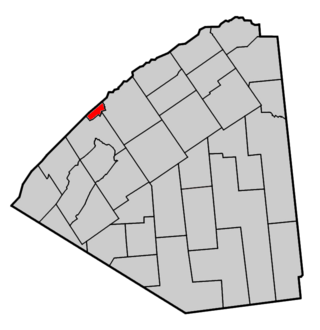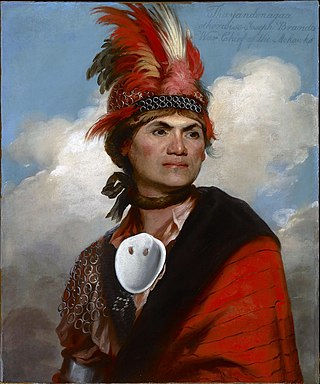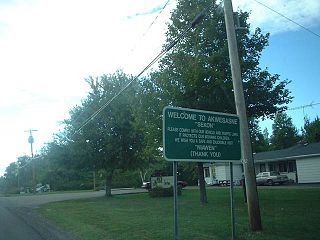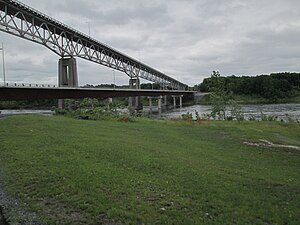
The St. Lawrence Seaway is a system of locks, canals, and channels in Canada and the United States that permits oceangoing vessels to travel from the Atlantic Ocean to the Great Lakes of North America, as far inland as Duluth, Minnesota, at the western end of Lake Superior. The seaway is named for the St. Lawrence River, which flows from Lake Ontario to the Atlantic Ocean. Legally, the seaway extends from Montreal, Quebec, to Lake Erie, and includes the Welland Canal. Ships from the Atlantic Ocean are able to reach ports in all five of the Great Lakes, via the Great Lakes Waterway.

The St. Lawrence River is a large international river in the middle latitudes of North America connecting the Great Lakes to the North Atlantic Ocean. Its waters flow in a northeasterly direction from Lake Ontario to the Gulf of St. Lawrence, traversing Ontario and Quebec in Canada and New York in the United States. A section of the river demarcates the Canada–U.S. border.

Ogdensburg is a city in St. Lawrence County, New York, United States. The population was 10,436 at the 2019 census. In the late 18th century, European-American settlers named the community after American land owner and developer Samuel Ogden. The city is at the northern border of New York at the mouth of the Oswegatchie River on the south bank of the St. Lawrence River. The only formally designated city in the county, it is located between Massena, New York to the east and Brockville, Ontario to the west.

St. Regis Mohawk Reservation is a Mohawk Indian reservation of the federally recognized tribe the St. Regis Mohawk Tribe, located in Franklin County, New York, United States. It is also known by its Mohawk name, Akwesasne. The population was 3,288 at the 2010 census. The reservation is adjacent to the Akwesasne reserve in Ontario and Quebec across the St. Lawrence River. The Mohawk consider the entire community to be one unit and have the right to travel freely across the international border.

Cornwall is a city in Eastern Ontario, Canada, situated where the provinces of Ontario and Quebec and the state of New York converge. It is the seat of the United Counties of Stormont, Dundas, and Glengarry and is Ontario's easternmost city.

The Mohawk people are the most easterly section of the Haudenosaunee, or Iroquois Confederacy. They are an Iroquoian-speaking Indigenous people of North America, with communities in southeastern Canada and northern New York State, primarily around Lake Ontario and the St. Lawrence River. As one of the five original members of the Iroquois League, the Mohawk are known as the Keepers of the Eastern Door – the traditional guardians of the Iroquois Confederation against invasions from the east.

The Thousand Islands International Bridge is an American-maintained international bridge system over the Saint Lawrence River connecting northern New York in the United States with southeastern Ontario in Canada. Constructed in 1937, with additions in 1959, the bridges span the Canada–US border in the middle of the Thousand Islands region. All bridges in the system carry two lanes of traffic, one in each direction, with pedestrian sidewalks.

The United Counties of Stormont, Dundas and Glengarry (SDG) is an upper-tier municipality in the Canadian province of Ontario that comprises three historical counties and excludes the City of Cornwall and the Mohawk Nation of Akwesasne. However, both Cornwall and Akwesasne form part of a larger census division named for the United Counties of Stormont, Dundas and Glengarry. The municipality's administrative office is located within Cornwall.

The Canada–United States border is the longest international border in the world. The terrestrial boundary is 8,891 km (5,525 mi) long. The land border has two sections: Canada's border with the contiguous United States to its south, and with the U.S. state of Alaska to its west. The bi-national International Boundary Commission deals with matters relating to marking and maintaining the boundary, and the International Joint Commission deals with issues concerning boundary waters. The agencies responsible for facilitating legal passage through the international boundary are the Canada Border Services Agency (CBSA) and U.S. Customs and Border Protection (CBP).

The Mohawk Nation at Akwesasne is a Mohawk Nation (Kanienʼkehá:ka) territory that straddles the intersection of international borders and provincial boundaries on both banks of the St. Lawrence River. Although divided by an international border, the residents consider themselves to be one community. They maintain separate police forces due to jurisdictional issues and national laws.

The Three Nations Crossing is a border crossing on the Canada–US border, connecting the city of Cornwall, Ontario in Canada to Massena, New York, in the United States. The crossing is associated with the Seaway International Bridge, which crosses the two channels on each side of Cornwall Island, which is located on the St. Lawrence River. The bridge is 4.7 km (2.9 mi) in length.
The New York and Ottawa Railway was a railway connecting Tupper Lake in northeastern New York to Ottawa, Ontario, via Ramsayville, Russell, Embrun, Finch and Cornwall. It became part of the New York Central Railroad system in 1913, although it was under the larger company's possession since the end of 1904. It had started out as the Northern Adirondack Railroad and evolved into the Northern New York Railroad, the New York and Ottawa Railroad, and was last known as the New York and Ottawa Railway before being merged into the New York Central and Hudson River Railroad. Other lines that were a part of this route are described below.
The Long Sault Parkway is a group of eleven islands west of Cornwall in the Canadian province of Ontario, as well as the name of the 10.1-kilometre (6.3 mi) scenic parkway connecting them. The islands, which include two public beaches and three campgrounds, were created by the flooding of the Long Sault rapids during construction of the St. Lawrence Seaway. The parkway, the islands, and their amenities are maintained by the St. Lawrence Parks Commission.

The Ogdensburg–Prescott International Bridge is a suspension bridge connecting Ogdensburg, New York in the United States to Johnstown, Ontario in Canada. Designed by Modjeski & Masters and completed in 1960, it has six spans and a main span of 350.75 metres (1,150.8 ft) totaling 2.4 kilometres (1.5 mi) across the Saint Lawrence River and Saint Lawrence Seaway. The bridge is owned and operated by the Ogdensburg Bridge and Port Authority, which also owns and operates Ogdensburg International Airport, the Port of Ogdensburg-Marine Terminal Facility, Commerce Park, the Port of Waddington, a medium-heavy industrial park and two short line railroads. The Ogdensburg Bridge and Port Authority is a New York State public-benefit corporation.

CKON-FM is a private radio station located in Akwesasne, a Mohawk nation territory that straddles the Canada–United States border. The station's studios are located in the Akwesasne Communication Society Building; that building is itself on both sides of the international border, with part of it being in Hogansburg, New York, and part of it in Saint Regis, Quebec. The ACS building was deliberately constructed on the international border as a symbol of Mohawk defiance between Canada and the United States, as well as an expression of communal unity.
The St. Lawrence Seaway Management Corporation (SLSMC), formerly known as the St. Lawrence Seaway Authority, is a nonprofit Canadian Corporation established in 1998 by the government of Canada, in partnership with Seaway users and other stakeholders, in order to ensure safe and efficient marine traffic. As dictated by the 1998 Canada Marine Act, the Corporation manages and operates the assets of the Crown entrusted to St. Lawrence Seaway, which consists of lands, Canals and 13 of the 15 locks between Montreal and Lake Erie, for the government under a long-term agreement with Transport Canada".
Rooseveltown is a hamlet in the town of Massena, New York, United States located in St. Lawrence County. It is near the eastern town line, by the Raquette River.

Cornwall Island is an island in the Saint Lawrence River, directly south of the city of Cornwall. The island is located completely within Canada, but it is also part of the Akwesasne Mohawk reserve, which straddles the Canada–United States border and the Quebec–Ontario border. The Seaway International Bridge, with a channel crossing on each side of the island, provides road access to Cornwall Island from both Canada and the United States.

The Moses-Saunders Power Dam, short for Robert Moses-Robert H. Saunders Power Dam, is a dam on the Saint Lawrence River straddling the border between the United States and Canada. It is located between Massena in New York and Cornwall in Ontario. The dam supplies water to two adjacent hydroelectric power generating stations, the United States' 912 MW St. Lawrence-Franklin D. Roosevelt Power Project and Canada's 1,045 MW R.H. Saunders Generating Station. Constructed between 1954 and 1958 as part of the larger Saint Lawrence Seaway project, the dam created Lake St. Lawrence. Aside from providing significant amounts of renewable power, the dam regulates the St. Lawrence River and affords passage for the navigation of large vessels. Despite the enormous economic advantages to the dam, it required the relocation of 6,500 people and caused harm to the surrounding environment. Efforts have been made over the years to improve shoreline and fish habitats.

















